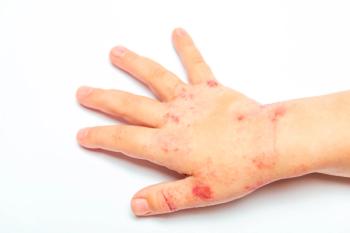
- Consultant for Pediatricians Vol 5 No 12
- Volume 5
- Issue 12
Photoclinic: Langerhans Cell Histiocytosis
Photoclinic: Langerhans Cell Histiocytosis
A 3-month-old boy was brought for evaluation of a rash of about 2 months' duration. The rash had persisted despite treatment with hydrocortisone butyrate 0.1% cream and an antifungal cream, which had been prescribed by a pediatrician for a presumed intertriginous rash of the groin.
The rash consisted of sharply demarcated, erythematous, nonscaling, nonpustular patches and involved the groin, genitalia, perirectal area, inner thighs, and abdomen. Erythematous papulovesicles, crusted papules (some excoriated), and hypopigmented macules were noted on the trunk and proximal extremities. The scalp had mild diffuse scaling.
The patient was referred to a dermatologist. A potassium hydroxide preparation of a scraping from the groin was positive for hyphae. Diaper dermatitis with secondary eczematous dermatitis was diagnosed. Twice-daily application of ciclopirox solution to the groin and hydrocortisone 2.5% ointment to all other involved areas was started. The dermatologist noted discharge from both ear canals and gum lesions in addition to the rash.
Robert Levine, DO, of Toms River, NJ, subsequently referred the infant to a local children's hospital where a skin biopsy revealed Langerhans cell histiocytosis. The infant had no systemic symptoms at that time.
Langerhans cell histiocytosis (formerly histiocytosis X) is an idiopathic group of disorders characterized by abnormal proliferation and infiltration of Langerhans cells. These cells, along with other white blood cells, form infiltrates or granulomas in various organs--including the lungs, bones, liver, spleen, CNS, and skin.
The skin is involved in more than 80% of patients with disseminated disease and in 30% of patients with less extensive disease.1 Seborrhea-like scaling of the scalp, petechial and purpuric lesions, ulcers, and bronzing of the skin may occur. This patient had multisystem disease of the skin, lungs, and liver.
The course of the disease is variable. Factors that point to a poor prognosis include failure to respond to therapy within the first 6 weeks, age younger than 2 years at onset, and extrapulmonary involvement.
Treatment of multisystem disease may include oral methylprednisolone, intravenous vinblastine, and (sometimes) methotrexate--which can eliminate disease and decrease long-term sequelae.
Because of concern for this child's worsening condition and because his parents would allow only alternative/homeopathic treatments, the patient was removed from his parents' custody by the state. He was hospitalized for further evaluation and treatment.
The patient's initial workup included a skeletal survey, which was negative for bone lesions, and a chest radiograph, which showed interstitial nodules in the lung parenchyma. A CT scan of the chest, abdomen, and pelvis revealed diffuse pulmonary nodules, as well as liver and splenic lesions. A CT scan of the head was normal. Levels of aspartate aminotransferase, alanine aminotransferase, and glutamic-oxaloacetic transaminase were elevated.
Because of the multiorgan involvement, a chemotherapy regimen--modeled on the current treatment protocol from LCH III, an ongoing clinical trial sponsored by the Histiocyte Society--was started. Treatment also included daily oral prednisone and weekly intravenous vinblastine. He was placed in medical foster care after discharge.
His foster mother reports that the infant's skin looks better. He is also much less fussy with diaper changes, is more alert and interactive, and has an excellent appetite.
Detailed information about histiocytosis can be obtained from the Histiocytosis Association of America: 800-548-2758 (available online at
References:
REFERENCE:
1.
Wolff K, Johnson RA, Suurmond D, eds.
Fitzpatrick's Color Atlas and Synopsis of Clinical Dermatology.
5th ed. New York: McGraw-Hill; 2005:515-518.
Articles in this issue
about 19 years ago
Rapid Diagnostic Testing for Influenza: When Does It Make Sense?about 19 years ago
6-Year-Old Girl With Marks on Neckabout 19 years ago
Parents Do Listenabout 19 years ago
Tinea Capitis and Tinea Corporisabout 19 years ago
Tinea Corporisabout 19 years ago
What Caused This Skin Eruption?about 19 years ago
Case in Point: Heart Block as the Presenting Symptom of Lyme Diseaseabout 19 years ago
Diagnostic Tips, Initial Management Strategiesabout 19 years ago
Case in Point: Young Girl With Pruritic, Coin-Shaped LesionsNewsletter
Access practical, evidence-based guidance to support better care for our youngest patients. Join our email list for the latest clinical updates.








